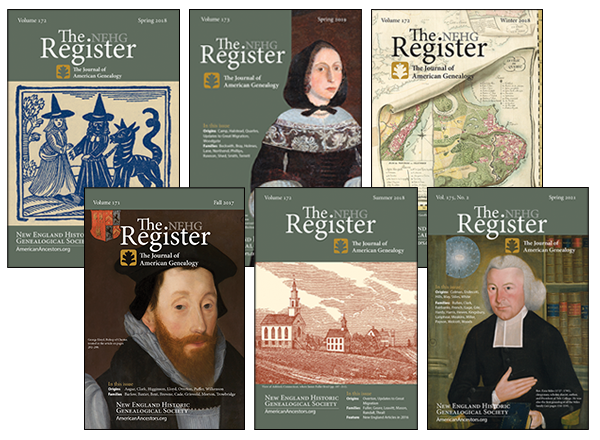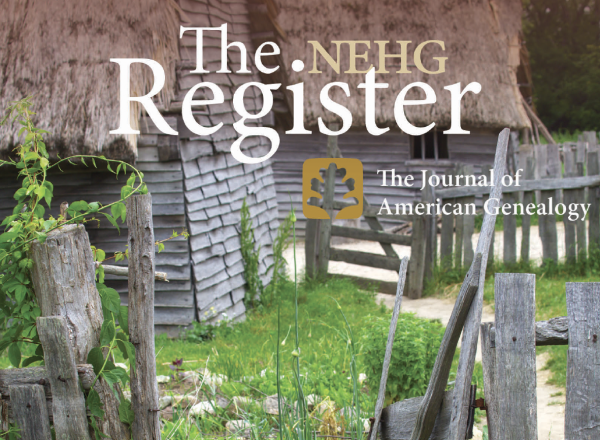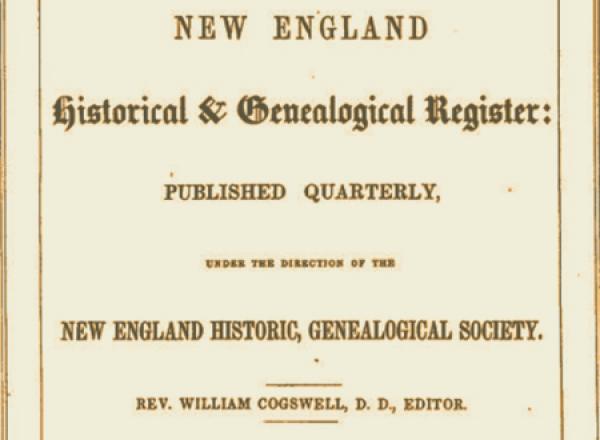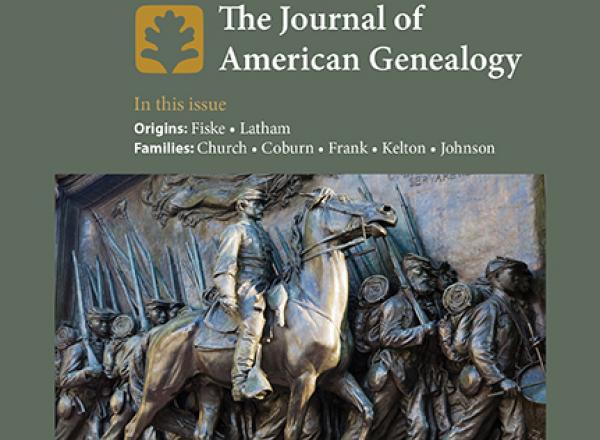About The Register
Published quarterly since 1847, The New England Historical and Genealogical Register is the flagship journal of American genealogy and the oldest in the field, focusing on authoritative compiled genealogies. Typical articles also solve genealogical problems, identify immigrant origins, or present treatments of multiple generations.

Latest Issue: Fall 2025, Vol. 179
Read the latest issue of the Register! Our lead article in this issue is The English Origin of Roger1 Chandler of Plymouth and Duxbury,
Massachusetts, with New Details on the Mayflower Crackstone, Allerton, Clarke, and Ely Families in Essex by Sue Allan and Caleb Johnson.
See below to preview this issue and read the editorial and a free article. Members of American Ancestors can download the full PDF of this issue at our past issues archive.

Volume 179, Whole #716
Fall 2025
Table of Contents
The English Origin of Roger1 Chandler of Plymouth and Duxbury, Massachusetts, with New Details on the Mayflower Crackstone, Allerton, Clarke, and Ely Families in Essex
Sue Allan and Caleb Johnson
The Family Bible of John2 Wood of Middletown, Rhode Island: Its History and Contents
Michael M. Wood
William Lyngwood of Braintree, Essex, and his Relationships with Several Founders of Hartford, Haddam, and Windsor, Connecticut
Jeff Bissey
Brewer6 Dodge of Massachusetts, New Hampshire, Vermont, and Lower Canada (concluded)
George W. Varney
Index of Subjects in Volume 179
Annual Table of Contents for Volume 179
Search the Register Database
Thousands of New England families have been treated in the pages of the journal and many more are referenced in incidental ways throughout. These articles range from short pieces correcting errors in print or solving unusual problems, to larger treatments of family origins. The Register database includes volumes 1 through 176 and holds 2.2 million searchable names.

Past Issues
The Register features articles on a wide variety of topics, including vital records, church records, tax records, land and probate records, cemetery transcriptions, obituaries, and historical essays. Authoritative compiled genealogies have been the centerpiece of the Register for more than 150 years.
Members can access an archive of all the past issues of the Register back to 2010.

Submit an Article
We welcome submissions of articles, especially from new authors.
BROADENED EDITORIAL FOCUS
Whether or not you have written for the Register previously, you might find that your research fits well within our broadened editorial focus, to help American Ancestors advance the study of family history in America and beyond.
We seek articles on:
- Families that migrated into or out of New England.
- Families of Irish, African American, Native American, Italian, Jewish, Portuguese, Dutch, German, French Canadian, or other backgrounds.
- Families that arrived in America as recently as the nineteenth or twentieth century.
TYPES OF ARTICLES
Our articles usually fall into one of the following categories:
- Immigrant origins with a genealogical summary.
- Problem-solving articles with a genealogical summary.
- Genealogical accounts of families, especially families for which no genealogy now exists. Because of space constraints, these accounts should normally be limited to three generations.
- Source material.
We rarely accept articles written in a “travelogue” style, describing the research process; we prefer instead to publish the results of research.
WRITING GUIDELINES
- Write using Microsoft Word, using 12-point type, with notes in 10-point type, with 1.5-inch side margins. You can download a Register template or use Microsoft Word’s “normal” style.
- Please do not create your own formatting and styles; do not use any automatic features or indexing.
- Articles should be 6,000 words or less.
- If applicable, try to identify the parents of spouses mentioned in the article.
- Pay attention to double dating, i.e., dates in January through March before 1752. It may be necessary to view the original record (if possible) to determine the correct date.
- Ensure that you have included a citation for each statement of fact that is not common knowledge. Each should be cited to one or more reliable sources. Download citation guidelines below.
- Once you have given a full title in a note, use a short title in later notes. Do not use ibid.
If you are writing about a seventeenth-century New England family, please consult the following four works and review the sources suggested in each:
- Clarence Almon Torrey, New England Marriages Prior to 1700, CD-ROM (American Ancestors, 2011), which is also available on CD-ROM and as a database at AmericanAncestors.org.
- Melinde Lutz Sanborn, Third Supplement to Torrey’s New England Marriages Prior to 1700 (Baltimore: Genealogical Publishing Co., 2003).
- Martin E. Hollick, New Englanders in the 1600s: A Guide to Genealogical Research Published Between 1980 and 2010, Expanded Edition (American Ancestors, 2012).
- Robert Charles Anderson, The Great Migration Directory, 2nd ed. (American Ancestors, 2025).
Remember that we are interested in the contents of your article more than the typographic style and formatting. You might find it useful to download and use our Register template. We also recommend reviewing relevant chapters in Guide to Genealogical Writing (American Ancestors, 2014) and reading “ Writing a Family Sketch in Register Style,” New England Ancestors 8:3 (Summer 2007):41–42, 45.
Download a Register-style template
SUBMISSION GUIDELINES
- Submit a description of your article in advance.
- Please limit articles to 6,000 words or less.
- Submit your article as an email attachment to register@americanancestors.org. If you prefer to submit a paper copy, or a file on CD, send to Editor, Register, P.O. Box 7786, Tacoma, WA 98417.
- Please consider sending us copies or scans of original documents along with your article.
- Please do not submit articles that have been published previously, either in print or online.
- Please do not submit an article that you are also submitting to another journal.
You should receive an acknowledgment within two weeks but may not learn for several months whether your article has been accepted for publication. Once accepted, it may not be published for at least one year.
If your article is accepted, you will receive a standard Register permission letter to sign. The letter grants American Ancestors a perpetual non-exclusive right to publish. During the editing process you will be able to review and comment on editorial changes to your article.